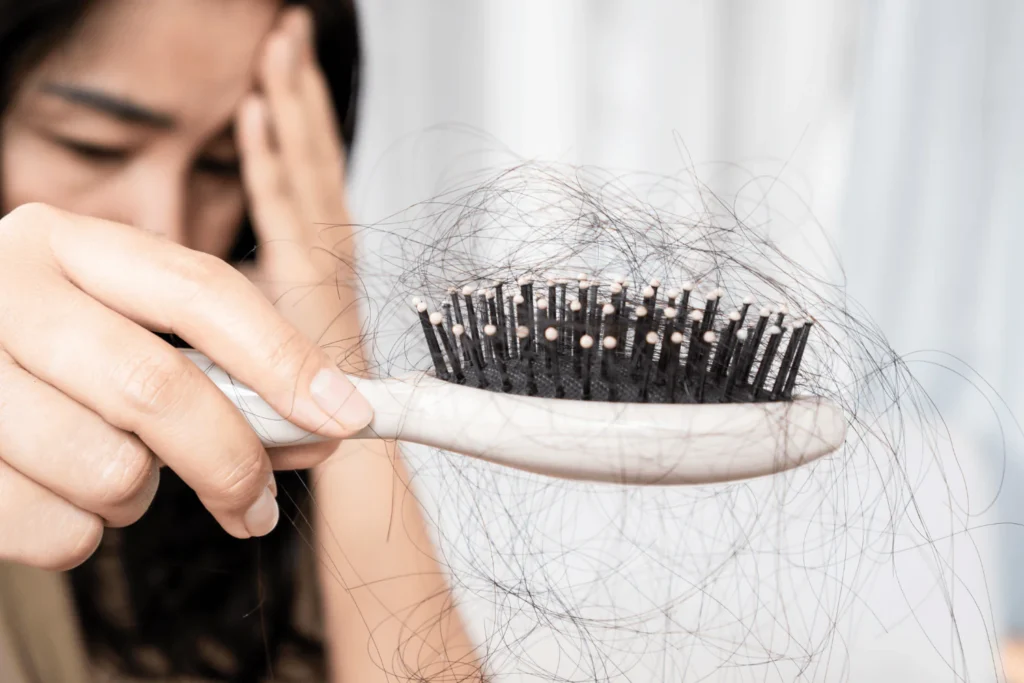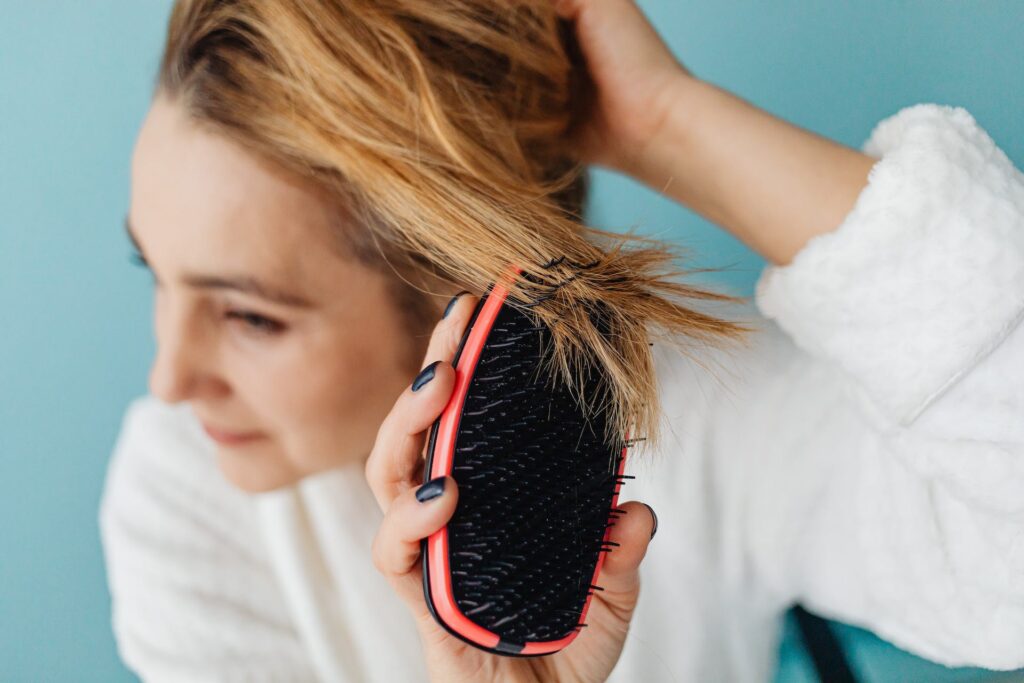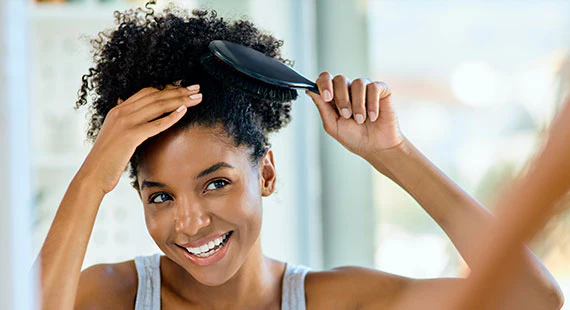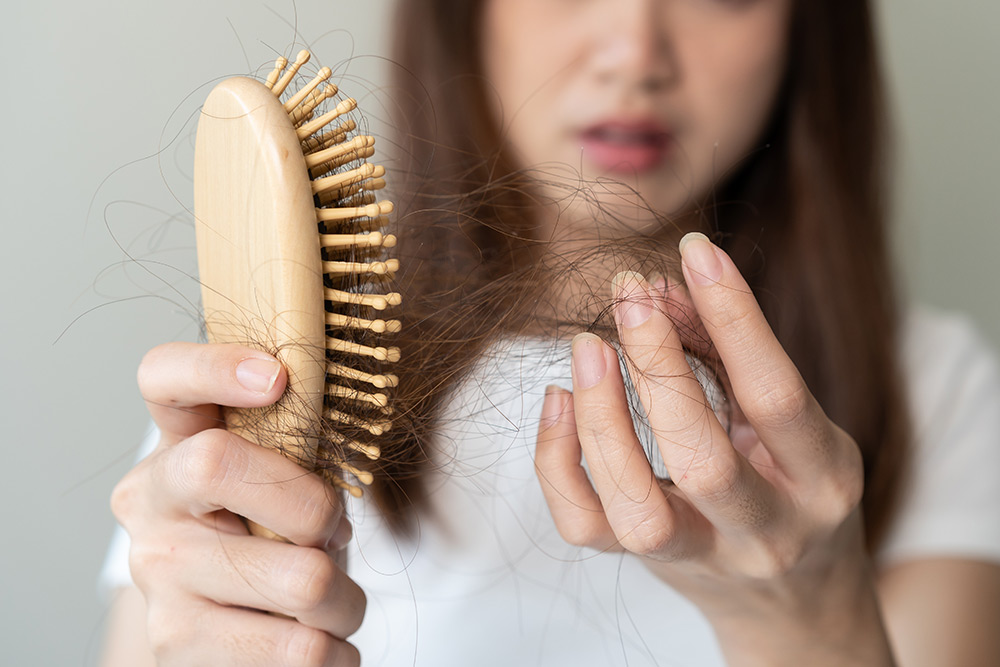Postpartum hair loss is a common experience for new moms, often starting a few months after childbirth. While it’s a natural part of the postpartum journey, losing clumps of hair can be frustrating and even alarming. The right hairbrush can make a big difference in reducing shedding, minimizing breakage, and promoting a healthy scalp.
Recommended: 7 Best Supplements for Postpartum Hair Loss
In this guide, we’ll explore the best brushes for postpartum hair loss, how they help, and additional tips to care for your hair during this transition.
Understanding Postpartum Hair Loss
Postpartum hair loss, also known as postpartum shedding, is a common condition many new moms experience a few months after giving birth. During pregnancy, increased estrogen levels prolong the hair’s growth phase, resulting in thicker, fuller hair. However, after childbirth, estrogen levels drop, causing more hair to enter the shedding phase all at once.

This sudden hair loss usually peaks around 3 to 6 months postpartum and can last for several months. While it may seem alarming, postpartum shedding is temporary, and hair typically returns to its normal growth cycle over time.
Recommended: Best Freezer Meal For Postpartum
Factors like stress, lack of sleep, and nutritional deficiencies can sometimes make hair loss more noticeable. Using the right hairbrush, adopting a gentle hair care routine, and maintaining a balanced diet can help minimize excessive shedding and support hair regrowth.
How the Right Brush Can Help Reduce Shedding
Choosing the right hairbrush is essential for managing postpartum hair loss. A gentle, high-quality brush can help reduce breakage, minimize excessive shedding, and promote scalp health. Here’s how the right brush makes a difference:
- Prevents Excessive Tugging – Brushes with soft, flexible bristles glide through hair smoothly, reducing tension and breakage.
- Stimulates the Scalp – Brushes with natural boar bristles or massaging tips help increase blood circulation, encouraging hair growth.
- Reduces Frizz and Breakage – Wide-tooth combs and detangling brushes prevent knots and pulling, keeping hair healthier.
- Distributes Natural Oils – Boar bristle brushes help spread natural scalp oils down the hair shaft, keeping hair hydrated and nourished.
- Suitable for Sensitive Hair – Brushes designed for fragile hair prevent further damage, ensuring a smoother recovery from postpartum shedding.
Recommended: Best Postpartum Gifts for Mom
By choosing the right brush and using gentle techniques, new moms can manage postpartum hair loss more effectively and support healthier hair regrowth.
Types of Brushes for Postpartum Hair Loss
Choosing the right brush can make a significant difference in managing postpartum hair loss. Here are the best types of brushes for minimizing shedding, reducing breakage, and promoting healthy hair regrowth:
- Boar Bristle Brush – Gently distributes natural scalp oils, reduces frizz, and prevents excessive pulling, making it ideal for delicate postpartum hair.
- Wide-Tooth Comb – Helps detangle wet hair without causing breakage, making it a must-have for moms experiencing hair thinning.
- Detangling Brush – Designed with flexible bristles to glide through knots smoothly, reducing hair fall caused by tugging.
- Scalp Massaging Brush – Stimulates blood circulation, promoting hair growth while gently exfoliating the scalp to remove buildup.
- Paddle Brush with Soft Bristles – Ideal for straight or slightly wavy hair, offering gentle detangling and smoothing without excessive pulling.
Recommended: Best Bathing Suits For Postpartum
Each of these brushes plays a role in maintaining healthier hair during the postpartum phase. Combining the right brush with a gentle hair care routine can help minimize shedding and support hair regrowth over time.
How to Properly Brush Postpartum Hair
Brushing postpartum hair the right way can help minimize shedding, reduce breakage, and promote healthier regrowth. Here’s a step-by-step guide to brushing your hair gently and effectively:
1. Start with a Wide-Tooth Comb
Before using a brush, use a wide-tooth comb to gently detangle wet or damp hair. Wet hair is more fragile and prone to breakage, so avoid tugging or pulling.
2. Use a Gentle, Flexible Brush
Opt for a boar bristle or detangling brush with soft, flexible bristles to minimize damage and distribute natural scalp oils.

3. Begin at the Ends
Start brushing from the ends of your hair and gradually work your way up to the roots. This prevents excessive pulling and reduces stress on the scalp.
Recommended: Best Postpartum Clothes for C-Section
4. Brush in Sections
Divide your hair into smaller sections and brush each part separately to avoid unnecessary tension, especially if your hair is thick or prone to tangling.
5. Avoid Over-Brushing
Brushing too often can weaken fragile postpartum hair. Stick to brushing once or twice a day to prevent unnecessary shedding.
6. Be Gentle on the Scalp
Use slow, smooth strokes rather than aggressive brushing to avoid irritating the scalp and worsening hair loss.
7. Clean Your Brush Regularly
Remove trapped hair and product buildup from your brush to keep it clean and effective. A dirty brush can transfer oils and residue back to your scalp, potentially affecting hair health.
By using the right techniques and tools, you can manage postpartum hair loss more effectively while keeping your hair healthy and strong.
Common Mistakes to Avoid When Dealing with Postpartum Hair Loss
Postpartum hair loss is a natural process, but certain habits can make it worse. Avoid these common mistakes to protect your hair and encourage healthy regrowth:
1. Overwashing Your Hair
Frequent washing can strip your scalp of natural oils, making hair more brittle and prone to breakage. Stick to washing 2–3 times a week with a gentle shampoo.
Recommended: How to Balance Hormones Naturally After Birth Control
2. Using Harsh Hair Products
Avoid products with sulfates, alcohol, and parabens, as they can dry out your scalp and weaken hair strands. Opt for nourishing, sulfate-free shampoos and conditioners.
3. Brushing Aggressively
Tugging on tangled hair can lead to excessive shedding and breakage. Use a wide-tooth comb or a soft-bristle brush, starting from the ends and working upward.
4. Tight Hairstyles
Pulling your hair into tight ponytails or buns adds stress to the roots, worsening hair loss. Instead, opt for loose hairstyles or soft scrunchies to reduce tension.
5. Ignoring Scalp Health
A healthy scalp promotes hair regrowth. Avoid buildup from dry shampoo or styling products, and consider using scalp massages or oils to improve circulation.
6. Skipping a Nutrient-Rich Diet
Poor nutrition can slow hair regrowth. Ensure your diet includes protein, iron, biotin, and omega-3 fatty acids to strengthen hair and promote new growth.
7. Stressing Too Much About Hair Loss
Stress can contribute to further hair shedding. Practice relaxation techniques like deep breathing, meditation, or light exercise to manage postpartum stress.
Recommended: Best Vitamins to Regulate Menstrual Cycle
Extra Hair Care Tips for Postpartum Moms
Managing postpartum hair loss requires a gentle and consistent approach. Here are some practical tips to help keep your hair healthy and strong during this phase:
1. Handle Your Hair with Care
Use a mild, sulfate-free shampoo to maintain moisture. Gently detangle hair with a soft-bristle brush or wide-tooth comb.

2. Limit Heat Styling
Reduce the use of blow dryers, curling irons, and straighteners. Always apply a heat protectant if styling with heat is necessary.
3. Choose Gentle Hairstyles
Avoid tight ponytails or buns that put stress on the scalp. Opt for loose styles like soft braids or messy buns to prevent breakage.
Recommended: When To Start Kegel Exercises After Hysterectomy
4. Support Hair Health with Proper Nutrition
Maintain a diet rich in protein, iron, and essential vitamins. Drink plenty of water and consider taking postpartum-safe supplements like biotin or collagen.
5. Focus on Scalp Care
Massage your scalp regularly to improve blood circulation and encourage hair growth. Use scalp-friendly treatments like nourishing oils or gentle exfoliants.
6. Sleep on a Silk Pillowcase
Reduces friction and prevents unnecessary hair breakage while sleeping.
7. Stay Patient and Positive
Postpartum hair loss is temporary—your hair will naturally regrow over time. Manage stress, as high stress levels can contribute to further shedding.
Conclusion
Postpartum hair loss is a natural and temporary phase that many new moms experience. While it can be frustrating, using the right brush, adopting a gentle hair care routine, and maintaining a healthy diet can make a significant difference in managing shedding and promoting regrowth. With patience and the right approach, your hair will regain its strength and fullness over time. Remember, self-care during this period is just as important as caring for your little one.
